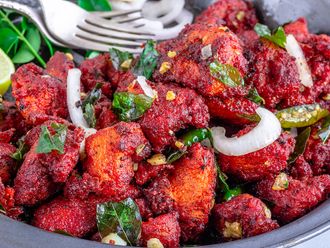
If you're looking for a very traditional Chinese New Year dish that's not only easy to make but is also healthy, try Yu Sheng, a salad of crisp vegetables and thinly sliced salmon that's seasoned before being tossed high in the air to wish for prosperity. While you don't have to throw the ingredients as high as possible, make sure you give it a good toss to ensure everything is covered with the sweet, fragrant dressing. Poonsak Sumonratanakul, the Thai executive chef at the Singaporean hotel Park Regis Kris Kin in Bur Dubai, shared his recipe and some background on the celebratory dish.
What is Yu Sheng, and why is it so important?
A vital part of any New Year celebration, Yu Sheng is a colourful salad of sliced fresh raw fish, usually salmon, mixed with crunchy shredded vegetables like carrots, ginger, capsicum, turnips and coriander, and a variety of sauces, oil, toasted sesame seeds and other condiments. The Cantonese word stands for prosperity, and the raw ingredients symbolise the renewal of life. Tradition calls for the ingredients to be mixed using chopsticks and then tossed in the air, as high as possible, while everyone at the table calls out "lo hei" in a chant for good fortune.
Do you eat it at any other time of year, or just New Year?
Traditionally, it is eaten during the New Year, but a lot of people eat it throughout the year. In the past Chinese fishermen feasted on their catches on the seventh day of the New Year. It is only since the mid-20th century, that the latest version of Yu Sheng, which traces its origin to the Southern Song Dynasty, has come to be associated with Chinese New Year celebrations in Singapore and Malaysia amongst the ethnic Chinese community.
Is it a Singaporean dish? Where does it come from?
It is originally a Chinese dish believed to have started in Guangzhou and later Chaozhou and Shantou. Recently it has been quite popular in Singapore, Hong Kong and Malaysia.
Do people eat it at home or in restaurants?
In the past people used to enjoy it at home. However, nowadays most people prefer to have it at restaurants because there are so many ingredients used in a single dish. It is just more convenient to eat out.
If someone doesn't like raw fish or can't find it fresh, is there a substitute?
One can always try it with smoked salmon or tuna fish — even tofu.
Do families make their own versions or is it a very fixed recipe?
As long as you have got the basics in place there isn't a hard and fast recipe. Unless you want to stick to the original, you can pretty much do your own thing. Traditionally, 27 ingredients were used for Yu Sheng. The latest versions have only about 20.
What are other Chinese New Year food traditions that you can tell me about?
There is always a New Year's Eve family dinner that is very sumptuous and traditionally includes chicken and fish on the menu besides an elaborate vegetarian dish. Other favourites include dumplings, noodles, nian gao (Chinese New Year Pudding), bakkwa (dried meat) and plenty of mandarins.
Yu Sheng
- 100g fresh salmon fillet, sliced into thin strips
- 2 white radishes, finely shredded
- 2 carrots, finely shredded
- 2 cucumbers, finely shredded
- 1 red capsicum, finely sliced
- 1 onion, finely chopped
- 1-inch piece of ginger, finely shredded
- 5 kaffir lime leaves, finely shredded
- 4 sprigs of fresh coriander
- 1 tbs five-spice powder
- 1/4 tsp sugar
- 1/8 tsp white pepper
- Juice of one lemon
For the dressing
- 2/3 cup plum sauce
- 2 tbs vegetable oil
- 1 tbs sesame oil
- Salt to taste
- 1/4 cup peanuts, chopped
- 1/4 cup sesame seeds, toasted
Arrange all the ingredients on a large serving platter. Season with a little salt and lime juice. Then mix the ingredients well. Pour over the dressing followed by sesame seeds and peanuts.
















